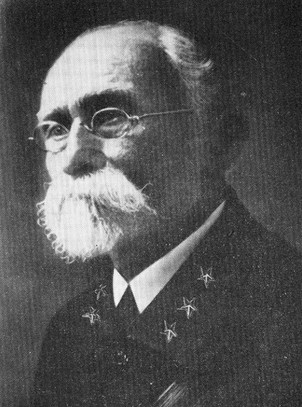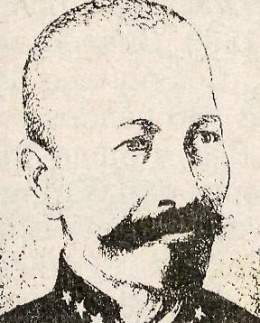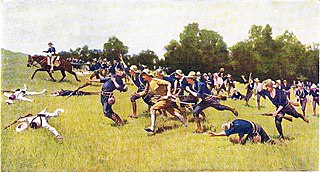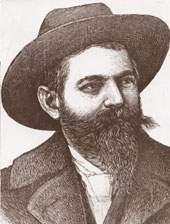
The Ten Years' War, also known as the Great War and the War of '68, was part of Cuba's fight for independence from Spain. The uprising was led by Cuban-born planters and other wealthy natives. On 10 October 1868, sugar mill owner Carlos Manuel de Céspedes and his followers proclaimed independence, beginning the conflict. This was the first of three liberation wars that Cuba fought against Spain, the other two being the Little War (1879–1880) and the Cuban War of Independence (1895–1898). The final three months of the last conflict escalated with United States involvement, leading to the Spanish–American War.

Lt. General José Antonio de la Caridad Maceo y Grajales was a Cuban general and second-in-command of the Cuban Army of Independence.

Máximo Gómez y Báez was a Cuban-Dominican Generalissimo in Cuba's War of Independence (1895–1898). He was known for his controversial scorched-earth policy, which entailed dynamiting passenger trains and torching the Spanish loyalists' property and sugar plantations—including many owned by Americans. He greatly increased the efficacy of the attacks by torturing and killing not only Spanish soldiers, but also Spanish sympathizers and especially Cubans loyal to Spain. By the time the Spanish–American War broke out in April 1898, the rebellion was virtually defeated in most of Western Cuba, with only a few operating pockets in the center and the east. He refused to join forces with the Spanish in fighting off the United States, and he retired to the Quinta de los Molinos, a luxury villa outside of Havana after the war's end formerly used by captains generals as summer residence.

The Cuban War of Independence, also known in Cuba as the Necessary War, fought from 1895 to 1898, was the last of three liberation wars that Cuba fought against Spain, the other two being the Ten Years' War (1868–1878) and the Little War (1879–1880). The final three months of the conflict escalated to become the Spanish–American War, with United States forces being deployed in Cuba, Puerto Rico, and the Philippine Islands against Spain. Historians disagree as to the extent that United States officials were motivated to intervene for humanitarian reasons but agree that yellow journalism exaggerated atrocities attributed to Spanish forces against Cuban civilians.

Juan Dionisio "Noni" Gil de la Rosa was a brigadier general in the Cuban Army of Independence, and fought in the Cuban War of Independence.

Jesús “Rabí” Sablón Moreno was a Cuban soldier and patriot of the 19th century.

The Second Eastern Campaign was a military campaign that took place between August 1 to 12, 1898, in the Oriente Province of Cuba during the Cuban War of Independence. It was the shortest military campaign of the entire war and it was the one that marked the end of Spanish reign in Cuba and the Spanish Empire in Latin America.

José Manuel Capote Sosa (1836–1934) was a Cuban Major General and politician who participated in the Cuban War of Independence. He was known as the mayor of Bayamo and the brother of Colonel Gonzalo Capote of the Cuban Liberation Army.
Rosendo Collazo was a Cuban senator, army colonel, and veteran of the Cuban War of Independence.

Enrique Collazo Tejada was a Cuban writer, army general, and distinguished veteran of the Ten Years' War and War of Independence.

Julio Grave de Peralta y Zayas was a Cuban army general who was killed in combat during the Ten Years' War.

Bernabé Varona, also known as Bembetta, was a Cuban revolutionary and mambí General who was executed during the Ten Years' War in 1873.

Manuel de Quesada y Loynaz was a Cuban revolutionary and the first General-in-Chief of the Cuban Liberation Army who fought against Spain in the Ten Years' War.

Antonio Zambrana was a Cuban lawyer, jurist, writer, and politician.
The Battle of Las Tunas was a military engagement of the Ten Years' War. It took place on August 16, 1869, in the city of Las Tunas, Oriente in Cuba. It was organized to rescue families of Cubans that were held in the town.
Enrique Boniche was a prominent Spanish military general who served in the Dominican Restoration War and the Ten Years' War in Cuba.
Tomás Collazo Tejada was a Cuban statesman, mambí Colonel, and veteran of the Cuban War of Independence.

Francisco Muñoz Rubalcava was a Cuban patriot, mambí soldier, and poet who was executed during the Ten Years' War in Cuba.

Belisario Grave de Peralta y Zayas was a Cuban army general during Cuba's Ten Years' War.
The Battle of El Salado occurred on January 7, 1869, during the Ten Years' War, near Salado River and the Salado settlement, in the municipality of Río Cauto, Granma Province, in Cuba.














